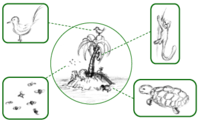
Photo from wikipedia
In this study, the aging of culturable FIB and DNA representing genetic markers for Enterococcus spp. (ENT1A), general Bacteroides (GB3), and human-associated Bacteroides (HF183) in freshwater sediments was evaluated. Freshwater… Click to show full abstract
In this study, the aging of culturable FIB and DNA representing genetic markers for Enterococcus spp. (ENT1A), general Bacteroides (GB3), and human-associated Bacteroides (HF183) in freshwater sediments was evaluated. Freshwater sediment was collected from four different sites within the upper and lower reach of the Topanga Creek Watershed and two additional comparator sites within the Santa Monica Bay, for a total of six sites. Untreated (ambient) and oven-dried (reduced microbiota) sediment was inoculated with 5% sewage and artificial freshwater. Microcosms were held for a 21-day period and sampled on day 0, 1, 3, 5, 7, 12, and 21. There were substantial differences in decay among the sediments tested, and decay rates were related to sediment characteristics. In the ambient sediments, smaller particle size and higher levels of organic matter and nutrients (nitrogen and phosphorus) were associated with increased persistence of the GB3 marker and culturable Escherichia coli (cEC) and enterococci (cENT). The HF183 marker exhibited decay rates of -0.50 to -0.96 day-1, which was 2-5 times faster in certain ambient sediments than decay of culturable FIB and the ENT1A and GB3 markers. The ENT1A and GB3 markers decayed at rates of between -0.07 and -0.28 and -0.10 to -0.44 day-1, and cEC and cENT decayed at rates of between -0.22 and -0.81 and -0.03 and -0.40 day-1, respectively. In the oven-dried sediments, increased persistence of all indicators and potential for limited growth of culturable FIB and the GB3 and ENT1A markers was observed. A simplified two-box model using the HF183 marker and cENT decay rates generated from the microcosm experiments was applied to two reaches within the Topanga Canyon watershed in order to provide context for the variability in decay rates observed. The model predicted lower ambient concentrations of enterococci in sediment in the upper (90 MPN g-1) versus lower Topanga watershed (530 MPN g-1) and low ambient levels of the HF183 marker (below the LLOQ) in sediments in both lower and upper watersheds. It is important to consider the variability in the persistence of genetic markers and FIB when evaluating indicators of fecal contamination in sediments, even within one watershed.
Journal Title: Water research
Year Published: 2017
Link to full text (if available)
Share on Social Media: Sign Up to like & get
recommendations!